Gigabyte 7VAXP-A Ultra: The KT400A in Retail Action
by Evan Lieb on March 31, 2003 3:19 AM EST- Posted in
- Motherboards
Gigabyte 7VAXP-A Ultra Revision 1.0: Basic Features
|
Motherboard Specifications |
|
|
CPU
Interface
|
Socket-462
|
|
Chipset
|
VIA
KT400A North Bridge (CD Stepping)
VIA VT8235 South Bridge (CD Stepping) |
|
Bus
Speeds
|
up
to 250MHz (in 1MHz increments)
|
|
Core
Voltages Supported
|
up
to 1.815V (in 2.5%/5% increments)
|
|
I/O
Voltages Supported
|
N/A
|
|
DRAM
Voltages Supported
|
up
to 2.8V in 0.1V increments
|
|
Memory
Slots
|
3
184-pin DDR DIMM Slots
|
|
Expansion
Slots
|
1
AGP 8X Slot
5 PCI Slots |
|
Onboard
RAID
|
Promise
PDC20276
|
|
Onboard
USB 2.0/IEEE-1394
|
USB2
Supported through South Bridge
VIA VT6306 IEEE-1394 Firewire Controller |
|
Onboard
LAN
|
Realtek
8100BL
|
|
Onboard
Audio
|
Realtek
ALC650 6-channel audio
|
|
Onboard
Serial ATA
|
Silicon
Image SI3112A
|
|
BIOS
Revision Tested
|
MG2
(03/14/2003)
|
Let's first start out by taking a look at the onboard LAN controller that is integrated on the PCB of the 7VAXP-A Ultra. The LAN controller is by Realtek, dubbed the RTL8100BL controller. This 10/100 LAN controller can be found on several high-end motherboards.
 |
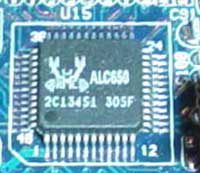 |
The onboard sound is powered by Realtek's ALC650 chip. This is in contrast to the VT1616 that VIA has been touting since the KT400A was launched a couple weeks ago. With Gigabyte using the ALC650 instead of the VT1616, VIA's claim to fame with the VT1616 doesn't apply, and any edge over MCP-T nForce2 motherboards is lost, even despite the fact that all nForce2 motherboards use Realtek's ALC650. We should also remind you that neither the VT8235 South Bridge (which will ship with the 7VAXP-A Ultra) nor the VT8237 South Bridge (which will ship with later versions of the 7VAXP-A Ultra in April/May) have dedicated DSP logic, whereas the nForce2 APU does.
The 7VAXP-A Ultra's I/O configuration includes two PS/2 ports, two serial ports, one parallel port, two rear USB 2.0 ports, one LAN port, a Game port, and three 1/8' jacks, which are driven by the onboard sound. Most users won't have any complaints about this configuration, though integrated SPDIF and FireWire ports would have been an excellent addition for a high-end mainboard like the 7VAXP-A Ultra.
The 7VAXP-A Ultra brings some excellent IDE support to the table. Firstly, the Primary and Secondary IDE connectors support two channels each, or up to four IDE drives in total (this includes ATAPI devices and hard drives).
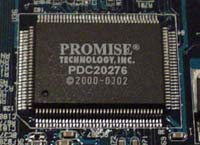
The IDE RAID PDC20276 controller powers the third and forth IDE connectors present on the PCB. Both the third and forth IDE connector support two channels each, or up to four IDE drives; this is exactly how the Primary and Secondary IDE connectors work, expect that the PDC20276 controller doesn't allow the third and forth IDE connectors to support ATAPI devices (e.g. CD/DVD ROM drives), only hard drives. This is a common limitation of IDE RAID controllers, though it shouldn't be too much of an issue if you don't need more than four optical drives in your system.
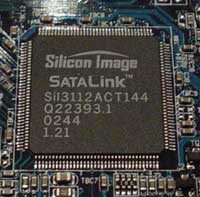
The Gigabyte 7VAXP-A Ultra uses Silicon Image's SI3112A Serial ATA controller as well. The 3112A controller is capable of supporting up to two independent Serial ATA devices as well as RAID 0 (striping) and RAID 1 (mirroring). Although Serial ATA drives have yet to hit the market in any sort of reasonable quantities, this board will have you ready for the transition as it ships with two Serial ATA cables. Unfortunately Gigabyte won't be shipping their 7VAXP-A Ultra with VIA's VT8237 South Bridge, which natively supports the Serial ATA150 standard. Having native Serial ATA support via the VT8237's own I/O link would free the 133MB/s-constranined PCI bus for other devices.
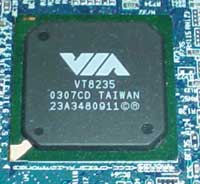
Now standard on all VIA chipset-based motherboards, the VT8235 South Bridge supports USB 2.0 technology like any other modern-day South Bridge. In total you can activate up to six USB 2.0 ports; two via the rear I/O ports and four via onboard USB 2.0 headers. Thankfully Gigabyte includes a four-port USB 2.0 bracket with all the rest of the 7VAXP-A Ultra's accessories. This will save you a little time and a few extra dollars if you were forced to purchase a USB 2.0 bracket.
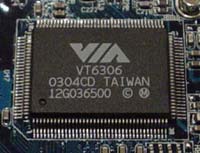
Another nice addition to the 7VAXP-A Ultra is FireWire. Gigabyte chooses the VT6306 FireWire controller to power the three available FireWire headers onboard the 7VAXP-A Ultra. So in total, you will be able to use three FireWire ports. However, Gigabyte only bundled a single-port FireWire bracket with the 7VAXP-A Ultra, which means you'll be two FireWire ports short of your potential. Hopefully Gigabyte will change this once they start shipping 7VAXP-A Ultra motherboards in April.










0 Comments
View All Comments